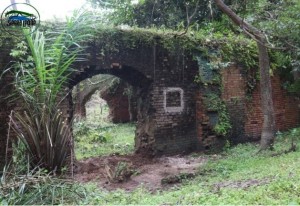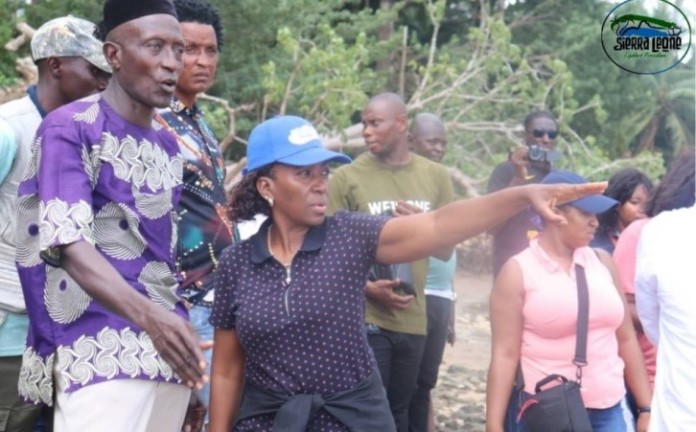The Minister of Tourism and Cultural Affairs, Nabeela Tunis, on the 9th September,2023 led a delegation, accompanied by Deputy Minister Kadijatu Grace Kamara, the Ministry’s Cultural Directorate, the Monument and Relics Commission, and Tour Operators, on a visit to Rotumba village in Koya Chiefdom.
During the visit, they conducted an inspection of the Portuguese Slave Fort and erected a plaque to preserve the historical relics.
Rotumba is known to be a Portuguese Slave Fort constructed in the 15th Century, situated on the banks of the Sierra Leone River, opposite Bunce Island. The site stands as a testament to the historical ties between the Portuguese and the British on Bunce Island.
Before commencing their tour of the relics, the Minister and her team paid their respects and offered greetings to the Chief of Rotumba village, Pa. Alimamy Brima II. On behalf of the Paramount Chief, he warmly welcomed the delegation and expressed his delight at the Ministry’s visit, viewing it as a developmental initiative for their village. He pledged his and the chiefdom’s full support to ensure the preservation of the historical relics, which he believed would bring benefits to the community.
In her address to the Chief and the stakeholders of Rotumba, Madam Nabeela Tunis expressed gratitude for the warm welcome extended to them. She explained that the purpose of their visit was to confirm the existence of the Portuguese Slave Fort, mark it for preservation, and raise awareness within the community about the significance of their historical heritage and the importance of its protection.
The Minister emphasized that the placement of a plaque signified the identification of the relics and their commitment to preserving them under the Ministry of Tourism and Cultural Affairs. She praised the community for safeguarding these relics, stating that their preservation would have a substantial economic impact on the lives and livelihoods of the village once the fort preservation project comes to fruition. She clarified that the project aimed not to dispossess the community of its land but to benefit them by opening the village to tourists and developing the community with necessary amenities.
During the guided tour of the historical site, Foday Jalloh, the Director of Culture, provided insights into the significance and historical importance of the Portuguese Slave Fort and the first Episcopal Church built in 1926. He emphasized that the fort holds great potential for colonial and slave tourism, suggesting the establishment of eco-lodges and the creation of a heritage tourism link between Bunce Island and the surrounding rivers in the estuary






We the people of Rotumba, Descendants, diasporas, associates and stakeholders would like to inform the Ministery of Tourism, Culture and Heritage that there are considerable interest and concerns as to what their intentions are in Rotumba.
As member of the Rotumba Development Programe, there are certain ventures which we have already started without any govrnmental support. Refurbishment of school, building a new primary school, paying teacher’ wages, buying uniform for children and buiding toilets in the village. However, we are not of the opinon of derailing any development from any faction. We will welcome your support, as long as it is the benefit of the local people. We are asking the Ministry for our involvement in any phase of your agenda to protect the relics of our forefathers and mothers.
We have representatives in Sierra and across the globe waiting patiently to be invited in these meetings. Tomorrow, our representative will be attending the meeting and document audio of the meeting as agreed by the section chief.
September 22, 2023
Dear Sir/Madam:
I write with great joy and hope in response to your article of September 13, 2023 titled “Tourism Ministry visits Rotumba Village, places plaque on Portuguese Fort” referencing the proposed restoration of the slave ruins left behind in my hometown of Rotumba, at the conclusion of the Trans-Atlantic Slave Trade. However, I couldn’t help but notice what I presume to be an innocent oversight on the part of the Ministry of Tourism or the article’s author for the mischaracterization of my place of birth, Rotumba.
You referred to Rotumba as a “Slave Fort” instead of accurately describing Rotumba as a “fishing village”. I was born in that village, right next to the structure and relics in question, seventy seven (77) years ago and I clearly understand what I’m talking about. As a result, I respectfully ask that you rectify this error so we could start off an the right foot and write an accurate narrative of the history of Rotumba for all to read. Thanks in advance for your cooperation.
And in closing, pleased be advised that we have an existing organization called the“Rotumba Development Group!” This group of young and old folks of Rotumba descent have raised funds not only to restore the dilapidated school building but also constructed a brand new building, provided uniforms for every student, purchased school supplies and paid every teacher’s monthly salary on time. The Administrator and contact person for this group is Mr. Nat Langley of Liverpool, England (+ 44 7479 679238).
I hope the Ministry and its representatives, developers, researchers, along with the media will contact this group from now on and make us a part of any pertinent negotiation, moving forward. I thank you so much for your understanding.
Sincerely,
Foday Brima Sesay (USA)
fsesay594@gmail.com